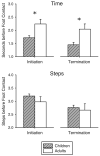Visually guided navigation: head-mounted eye-tracking of natural locomotion in children and adults
- PMID: 20932993
- PMCID: PMC3013502
- DOI: 10.1016/j.visres.2010.09.024
Visually guided navigation: head-mounted eye-tracking of natural locomotion in children and adults
Abstract
The current study showed that visual fixation of obstacles is not required for rapid and adaptive navigation of obstacles. Children and adults wore a wireless, head-mounted eye-tracker during a visual search task in a room cluttered with obstacles. They spontaneously walked, jumped, and ran through the room, stepping up, down, and over obstacles. Both children and adults navigated adaptively without fixating obstacles, however, adults fixated less often than children. We discuss several possibilities for why obstacle navigation may shift from foveal to peripheral control over development.
Copyright © 2010 Elsevier Ltd. All rights reserved.
Figures





References
-
- Adolph KE. Learning in the development of infant locomotion. Monographs of the Society for Research in Child Development. 1997;62 - PubMed
-
- Adolph KE. Specificity of learning: Why infants fall over a veritable cliff. Psychological Science. 2000;11:290–295. - PubMed
-
- Adolph KE, Berger SE. Motor development. In: Kuhn D, Siegler RS, editors. Handbook of child psychology: Vol 2 Cognition, perception, and language. 6th. New York: John Wiley & Sons; 2006. pp. 161–213.
-
- Adolph KE, Eppler MA. Development of visually guided locomotion. Ecological Psychology. 1998;10:303–321.
Publication types
MeSH terms
Grants and funding
LinkOut - more resources
Full Text Sources
Miscellaneous

